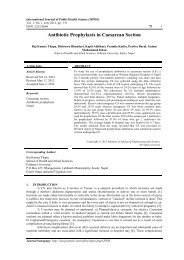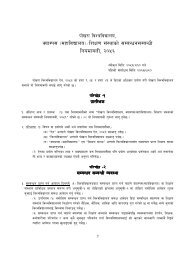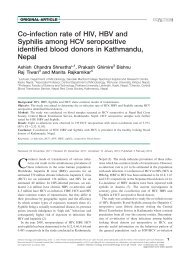Nasal Carriage Rate of Staphylococcus aureus in Hospital ...
Nasal Carriage Rate of Staphylococcus aureus in Hospital ...
Nasal Carriage Rate of Staphylococcus aureus in Hospital ...
Create successful ePaper yourself
Turn your PDF publications into a flip-book with our unique Google optimized e-Paper software.
Sah et. al. <strong>Nasal</strong> <strong>Carriage</strong> <strong>Rate</strong> <strong>of</strong> <strong>Staphylococcus</strong> <strong>aureus</strong> <strong>in</strong>...... JHAS, 2013, Vol. 3, No. 1 P 21-23<br />
<strong>Nasal</strong> <strong>Carriage</strong> <strong>Rate</strong> <strong>of</strong> <strong>Staphylococcus</strong> <strong>aureus</strong> <strong>in</strong><br />
<strong>Hospital</strong> Personnel <strong>of</strong> National Medical College and Teach<strong>in</strong>g <strong>Hospital</strong> and their<br />
Antibiotic Susceptibility Pattern<br />
1<br />
Prakash Sah, 1 Komal Raj Rijal, 2 Bikash Shakya, 3 Bishnu Raj Tiwari, 1 Prakash Ghimire<br />
1<br />
Central Department <strong>of</strong> Microbiology, Tribhuvan University, Kirtipur, Nepal<br />
2<br />
Department <strong>of</strong> Microbiology, National Medical College and Teach<strong>in</strong>g <strong>Hospital</strong>, Birgunj, Nepal<br />
3<br />
School <strong>of</strong> Health and Allied Sciences, Pokhara University, Kaski, Nepal<br />
ABSTRACT<br />
<strong>Nasal</strong> carriage <strong>of</strong> S. <strong>aureus</strong> has been identified as a risk factor for community-acquired and nosocomial <strong>in</strong>fections. Healthy<br />
hospital personnel may carry pathogenic hospital stra<strong>in</strong>s <strong>in</strong> their nose and sk<strong>in</strong> and may spread these pathogens to the<br />
community lead<strong>in</strong>g to more dreadful condition. This study was carried out at National Medical College & Teach<strong>in</strong>g <strong>Hospital</strong><br />
with the objective to study the nasal carriage <strong>of</strong> <strong>Staphylococcus</strong> aurues among the staffs at the hospital. A total <strong>of</strong> 54 nasal<br />
swabs were taken from the hospital staff. All the samples were processed follow<strong>in</strong>g standard microbiological method. Gram<br />
positive cocci that were mannitol ferment<strong>in</strong>g, catalase positive and coagulase positive isolates were considered as S. <strong>aureus</strong>.<br />
<strong>Nasal</strong> carriage rate <strong>of</strong> S. <strong>aureus</strong> among hospital staff was found to be 20.37%. <strong>Carriage</strong> among male and female staff was<br />
19% and 21.2% respectively (p>0.05). All nasal S. <strong>aureus</strong> isolates were sensitive to Amikac<strong>in</strong> and Vancomyc<strong>in</strong>. Methicill<strong>in</strong><br />
resistance rate was found to be 45.5%. High rate <strong>of</strong> nasal carriage <strong>of</strong> S. <strong>aureus</strong> <strong>in</strong>dicates need for standard <strong>in</strong>fection control<br />
practices to prevent transmission.<br />
Key words: <strong>Hospital</strong> staff, <strong>Nasal</strong> <strong>Carriage</strong>, S. <strong>aureus</strong><br />
Correspond<strong>in</strong>g address: Mr. Komal Raj Rijal, Central Department <strong>of</strong> Microbiology, Tribhuvan University,<br />
Kirtipur, Kathmandu. E-mail: rijalkomal@yahoo.com<br />
INTRODUCTION<br />
Staphylococci colonize sk<strong>in</strong> and nasal mucosa as their<br />
normal <strong>in</strong>habitants. Among staphylococci, S. <strong>aureus</strong> is the<br />
most virulent, and it is associated with a wide spectrum <strong>of</strong><br />
diseases, <strong>in</strong>clud<strong>in</strong>g sk<strong>in</strong> and s<strong>of</strong>t tissue, systemic <strong>in</strong>fections<br />
and exotox<strong>in</strong> related diseases. 1,2 <strong>Nasal</strong> carriage <strong>of</strong> S. <strong>aureus</strong><br />
has been identified as a risk factor for community-acquired<br />
and nosocomial <strong>in</strong>fections. 3 Healthy hospital personnel<br />
may carry pathogenic hospital stra<strong>in</strong>s <strong>in</strong> their nose and sk<strong>in</strong><br />
and may spread these pathogens to the community lead<strong>in</strong>g<br />
to more dreadful condition. 4 Healthcare workers, who<br />
have direct contact with persistently colonized patients, or<br />
contam<strong>in</strong>ated objects <strong>in</strong> the immediate environment around<br />
them can contam<strong>in</strong>ate their hands and subsequently transmit<br />
the organism to other patients. A subset <strong>of</strong> these will rema<strong>in</strong><br />
as nasal carrier for a prolonged period <strong>of</strong> time and may spread<br />
the organism to patients by direct contact transmission. 5 The<br />
fact that huge portions <strong>of</strong> healthy population carry S. <strong>aureus</strong><br />
<strong>in</strong> their nose and body surfaces is responsible for the fast<br />
spread <strong>of</strong> the staphylococcal <strong>in</strong>fections and the situation<br />
seems worse <strong>in</strong> hospitals. So, study <strong>of</strong> S. <strong>aureus</strong> as nasal<br />
carrier is <strong>of</strong> importance, especially <strong>in</strong> people concerned with<br />
hospitals to explore the clear picture regard<strong>in</strong>g its existence.<br />
S. <strong>aureus</strong> is carried <strong>in</strong> the anterior nares <strong>of</strong> 40% <strong>of</strong> healthy<br />
<strong>in</strong>dividuals. 6 In general; nasal carriage rates among hospital<br />
personnel and patient (60-70%) are much higher than those<br />
<strong>in</strong> community carriers (30-50%). 7 Pant and Rai reported nasal<br />
carriage rate <strong>of</strong> S. <strong>aureus</strong> among the healthcare staffs at Nepal<br />
Medical College, Kathmandu to be 43.8%. 8 In a similar<br />
study carried out at National Medical College and Teach<strong>in</strong>g<br />
<strong>Hospital</strong>, Birgunj, Shakya and co-workers reported nasal<br />
carriage rate <strong>of</strong> 12.5% out <strong>of</strong> which 57.1% were resistant<br />
to methicill<strong>in</strong>. 9 In another study carried out at a teach<strong>in</strong>g<br />
hospital <strong>in</strong> Kathmandu, nasal carriage rate <strong>of</strong> S. <strong>aureus</strong> was<br />
reported to be 27.13% among healthcare workers. 10 Studies<br />
have found that screen<strong>in</strong>g and eradication <strong>of</strong> nasal carrier for<br />
S. <strong>aureus</strong> decrease the <strong>in</strong>cidence <strong>of</strong> nosocomial <strong>in</strong>fections. 11,12<br />
In this study we report the nasal carriage rate <strong>of</strong> S. <strong>aureus</strong><br />
among healthcare workers at National Medical College and<br />
Teach<strong>in</strong>g <strong>Hospital</strong> (NMCTH), Birgunj, Nepal.<br />
MATERIAL AND METHODS<br />
Sample collection: <strong>Nasal</strong> swabs from 54 healthcare workers<br />
at NMCTH, Birgunj were collected dur<strong>in</strong>g the period <strong>of</strong><br />
April to June 2011. <strong>Nasal</strong> swabs were collected from anterior<br />
nares <strong>of</strong> the staffs by us<strong>in</strong>g sterile cotton swabs. The swab<br />
was <strong>in</strong>troduced 2-3 cm <strong>in</strong> the nasal cavity and rotated 4-5<br />
times both clockwise and anticlockwise. The swabs were<br />
then immediately transported to the laboratory for further<br />
process<strong>in</strong>g.<br />
Sample Process<strong>in</strong>g and Bacterial Identification: Specimens<br />
were <strong>in</strong>oculated onto Mannitol salt agar (MSA) and <strong>in</strong>cubated<br />
at 37 0 C for 48 hours. Mannitol ferment<strong>in</strong>g colonies that were<br />
yellow or golden yellow were selected and sub-cultured<br />
on Nutrient agar (NA). Colonies on Nutrient Agar were<br />
subjected to gram’s sta<strong>in</strong><strong>in</strong>g, catalase test and coagulase test.<br />
21
Sah et. al. <strong>Nasal</strong> <strong>Carriage</strong> <strong>Rate</strong> <strong>of</strong> <strong>Staphylococcus</strong> <strong>aureus</strong> <strong>in</strong>...... JHAS, 2013, Vol. 3, No. 1 P 21-23<br />
The gram positive, catalase positive and coagulase positive<br />
isolates were identified as S. <strong>aureus</strong>.<br />
Antibiotic susceptibility test<strong>in</strong>g: Antibiotic susceptibility<br />
test<strong>in</strong>g <strong>of</strong> all isolates was performed by modified Kirby Bauer<br />
disc diffusion method as recommended by CLSI guidel<strong>in</strong>es. 13<br />
The antibiotics used <strong>in</strong> the study were Amikac<strong>in</strong>, Ceftriaxone,<br />
Cotrimoxazole, Cipr<strong>of</strong>loxac<strong>in</strong>, Gentamyc<strong>in</strong>, Methicill<strong>in</strong>,<br />
Penicill<strong>in</strong>, and Vancomyc<strong>in</strong>.<br />
RESULT<br />
A total <strong>of</strong> 54 nasal swabs were taken from Health Care<br />
Workers (HCWs), 11 (20.37%) were positive for S. <strong>aureus</strong><br />
(Figure: 1). Twenty one nasal samples were taken from male<br />
HCWs and Thirty three samples from female HCWs. The<br />
nasal carriage rate <strong>in</strong> male and female HCWs were found to<br />
be 4 (19%) and 7 (21.2%) respectively (Table 1). The nasal<br />
samples were collected from different wards. The wards<br />
<strong>in</strong>cluded ICU, HD unit, Surgery ward (male), Surgery ward<br />
(female), POW, Medical ward, Orthopedic and OT. However,<br />
S. <strong>aureus</strong> growth was obta<strong>in</strong>ed only <strong>in</strong> samples from ICU,<br />
Surgery ward (male), Surgery ward (female), POW, Medical<br />
ward and OT. The high number <strong>of</strong> S. <strong>aureus</strong> was isolated<br />
from ICU (n=3) followed by female surgery ward (n=2),<br />
POW (n=2), OT (n=2), Medical ward (n=1) and male surgery<br />
ward (n=1) (Table 2).<br />
(36.4%), methicill<strong>in</strong> (45.5%). Penicill<strong>in</strong> was found to be the<br />
least effective antibiotic with resistance rate <strong>of</strong> 90.9 %.<br />
Table 2: <strong>Nasal</strong> carriage among staff <strong>of</strong> different wards<br />
S N. Wards No. <strong>of</strong> Sample S. <strong>aureus</strong> isolated<br />
1 ICU 11 3<br />
2 HD 3 0<br />
3 Surgery (male) 7 1<br />
4 Surgery (female) 6 2<br />
5 POW 8 2<br />
6 Medical 7 1<br />
7 Orthopedic 7 0<br />
8 OT 5 2<br />
Total 54 11 (20.37%)<br />
Table 3: Antibiotic susceptibility pattern <strong>of</strong> S. <strong>aureus</strong><br />
Antibiotics Sensitive Resistant<br />
Penicill<strong>in</strong> 1 (9.1%) 10 (90.9%)<br />
Methicill<strong>in</strong> 6 (54.5%) 5 (45.5%)<br />
Ceftriaxone 7 (63.6%) 4 (36.4%)<br />
Amikac<strong>in</strong> 11 (100%) 0<br />
Gentamyc<strong>in</strong> 8 (72.7%) 3 (27.3%)<br />
Cipr<strong>of</strong>loxac<strong>in</strong> 7 (63.6%) 4 (36.4%)<br />
Erythromyc<strong>in</strong> 9 (81.8%) 2 (18.2%)<br />
Vancomyc<strong>in</strong> 11 (100%) -<br />
Total no <strong>of</strong> S. <strong>aureus</strong> isolates 11<br />
Figure 1: Percentage <strong>of</strong> nasal carrier and non-carrier <strong>of</strong><br />
S. <strong>aureus</strong> among staffs under study.<br />
Table 1: Gender-wise distribution <strong>of</strong> S. <strong>aureus</strong> among<br />
health care workers<br />
Gender Carrier Non-carrier Total p-value<br />
Male 4 17 21<br />
Female 7 26 33<br />
Total 11 43 54<br />
p>0.05<br />
All isolates <strong>of</strong> S. <strong>aureus</strong> from HCWs were subjected for antibiotic<br />
susceptibility test. All S. <strong>aureus</strong> isolated from nasal samples<br />
were sensitive towards vancomyc<strong>in</strong> and amikac<strong>in</strong> (Table 3).<br />
The resistance rate to erythromyc<strong>in</strong> was 18.2% followed<br />
by ceftriaxone (36.4%), gentamyc<strong>in</strong> (27.3%), cipr<strong>of</strong>loxac<strong>in</strong><br />
DISCUSSION<br />
The nasal carriage rate <strong>of</strong> S. <strong>aureus</strong> among HCWs was<br />
found to be 20.37%. The carriage rate was higher among<br />
female HCWs than the male HCWs (P>0.05). In a similar<br />
study carried out at National medical college and Teach<strong>in</strong>g<br />
<strong>Hospital</strong>, Birgunj, Shakya and co-workers reported nasal<br />
carriage rate <strong>of</strong> 12.5% among patients, visitors and HCWs<br />
with nasal carriage rate among HCWs be<strong>in</strong>g 25% which<br />
is slightly higher than our f<strong>in</strong>d<strong>in</strong>g. 9 This may be due to<br />
the difference <strong>in</strong> sample size <strong>in</strong> these studies. Na’was and<br />
Fakhoury have reported prevalence <strong>of</strong> S. <strong>aureus</strong> among<br />
general hospital staffs <strong>in</strong> North Jordan to be 19.8% which is<br />
similar to our f<strong>in</strong>d<strong>in</strong>gs. 14 In another hospital based study, the<br />
overall carriage was 34.42 per cent with a significantly higher<br />
rate <strong>in</strong> females (67.53%) than <strong>in</strong> males (23.81%). 15 Akoua 16<br />
and co-workers conducted a similar study and have reported<br />
the carriage rate <strong>of</strong> S. <strong>aureus</strong> 45.4% whereas Farzana 17 and<br />
co-workers have reported carriage rate <strong>of</strong> S. aurues among<br />
healthcare workersto be 48%. In other different reports<br />
S. <strong>aureus</strong> carriage was 27.5% and 34.9% <strong>in</strong> health care<br />
workers. 18,19 Pant and Rai reported nasal carriage rate <strong>of</strong> S.<br />
aurues among the healthcare staffs at Nepal medical college<br />
and teach<strong>in</strong>g hospital to be 43.8%. 8 In another study carried<br />
out at a Tribhuvan University Teach<strong>in</strong>g <strong>Hospital</strong>, Marajgunj,<br />
Kathmandu, nasal carriage rate <strong>of</strong> S. <strong>aureus</strong> was reported to<br />
be 27.13% among healthcare workers. 10<br />
22
Sah et. al. <strong>Nasal</strong> <strong>Carriage</strong> <strong>Rate</strong> <strong>of</strong> <strong>Staphylococcus</strong> <strong>aureus</strong> <strong>in</strong>...... JHAS, 2013, Vol. 3, No. 1 P 21-23<br />
S. <strong>aureus</strong> is one <strong>of</strong> the most common causes <strong>of</strong> hospitalacquired<br />
<strong>in</strong>fections. It has been found that nasal carriage <strong>of</strong> S.<br />
<strong>aureus</strong> is a well-def<strong>in</strong>ed risk factor for subsequent <strong>in</strong>fection<br />
<strong>in</strong> nearly all categories <strong>of</strong> hospitalized patients. In this study<br />
as most <strong>of</strong> the isolates belonged to the HCWs at ICU, POW,<br />
OT, and surgical wards, the vulnerability <strong>of</strong> the <strong>in</strong>fection<br />
S. aurues among the patients, follow<strong>in</strong>g transmission<br />
from the healthcare providers, further complicat<strong>in</strong>g the<br />
treatment and recovery, cannot be ignored. Studies have<br />
found that screen<strong>in</strong>g and eradication <strong>of</strong> nasal carrier for S.<br />
<strong>aureus</strong> decrease the <strong>in</strong>cidence <strong>of</strong> nosocomial <strong>in</strong>fections. 11,<br />
12<br />
Thus surveillance for the determ<strong>in</strong>ation <strong>of</strong> carriers and<br />
their subsequent treatment for the eradication <strong>of</strong> the carriers<br />
help to significantly decrease the <strong>in</strong>cidence <strong>of</strong> nosocomial<br />
<strong>in</strong>fections. The nasal isolates <strong>of</strong> S. <strong>aureus</strong> showed a high<br />
degree <strong>of</strong> resistance towards different antibiotics tested.<br />
The most effective antibiotic was vancomyc<strong>in</strong> and amikac<strong>in</strong><br />
23<br />
with all isolates be<strong>in</strong>g susceptible. Similar results have<br />
been reported by Shanmugam et al., 20 and by various other<br />
workers. 9, 17 our study showed, 45.5% isolates <strong>of</strong> S. <strong>aureus</strong><br />
were resistant to methicill<strong>in</strong>. Shakya et al., have reported<br />
a higher rate <strong>of</strong> resistance <strong>of</strong> S. <strong>aureus</strong> aga<strong>in</strong>st methicill<strong>in</strong>.<br />
The difference may be attributed to different sample size <strong>in</strong><br />
the two studies and also the <strong>in</strong>clusion <strong>of</strong> patients and visitor,<br />
apart from HCWs, <strong>in</strong> the study. A high resistance rate was<br />
found for cipr<strong>of</strong>loxac<strong>in</strong> also which is similar to that reported<br />
by Shakya et al., <strong>in</strong> a similar study at same hospital. 9 The<br />
nasal carriage <strong>of</strong> methicill<strong>in</strong> resistant S. <strong>aureus</strong> among HCWs<br />
has <strong>in</strong>dicated the chances <strong>of</strong> transmission <strong>of</strong> the organism to<br />
the patients dur<strong>in</strong>g patient-care. The healthcare personnel<br />
require awareness regard<strong>in</strong>g the nosocomial <strong>in</strong>fection and<br />
should know their status <strong>of</strong> nasal carriage <strong>of</strong> MRSA and<br />
accord<strong>in</strong>gly, take necessary measures to prevent possible<br />
transmission.<br />
REFERENCES<br />
1. Shittu AO, Johnson L. Antimicrobial susceptibility patterns and characterization <strong>of</strong> cl<strong>in</strong>ical isolates <strong>of</strong> <strong>Staphylococcus</strong><br />
<strong>aureus</strong>. BMC Infect Dis. 2006; 124:2334-36.<br />
2. Tacconella E, Tumberello M, Cauda R. <strong>Staphylococcus</strong> <strong>aureus</strong> <strong>in</strong>fections. N Engl J. Med. 1998; 339:2026-29.<br />
3. Cole AM, Tahk S, Oren A. Determ<strong>in</strong>ants <strong>of</strong> <strong>Staphylococcus</strong> <strong>aureus</strong> <strong>Nasal</strong> <strong>Carriage</strong>. Cl<strong>in</strong> Diag Lab Immun. 2001; 8:164-9.<br />
4. Nakanishi M, Shrestha HG, Rai SK. Text Book <strong>of</strong> Medical Laboratory Technology, 1 st Edition. Medical Education Project<br />
JICA, TUTH, Kathmandu Nepal. 1996; pp. 359.<br />
5. Boyce JM. Prevent<strong>in</strong>g Staphylococcal Infections by Eradicat<strong>in</strong>g <strong>Nasal</strong> <strong>Carriage</strong> <strong>of</strong> <strong>Staphylococcus</strong> <strong>aureus</strong>. Infect Control<br />
Hosp Epidemiol. 1996; 18:622-7.<br />
6. Cheesbrough M. District Laboratory Practice <strong>in</strong> Tropical countries. Cambridge University Press, London. Part 2: 2000;<br />
196-274.<br />
7. Lowy FD. <strong>Staphylococcus</strong> <strong>aureus</strong> <strong>in</strong>fections. N Engl J Med. 1998; 339:520-32.<br />
8. Pant J, Rai SK. Occurrence <strong>of</strong> <strong>Staphylococcus</strong> <strong>aureus</strong> <strong>in</strong> hospital environment and staffs <strong>in</strong> teach<strong>in</strong>g hospital <strong>in</strong> Kathmandu,<br />
Nepal. J NAMLS. 2007; 8:72-3.<br />
9. Shakya B, Shrestha S, Mitra T. <strong>Nasal</strong> carriage rate <strong>of</strong> methicill<strong>in</strong> resistant <strong>Staphylococcus</strong> <strong>aureus</strong> among at National<br />
Medical College Teach<strong>in</strong>g <strong>Hospital</strong>, Birgunj, Nepal. NMCJ. 2010; 12(1):26-29.<br />
10. Shrestha B, Pokhrel BM, Mohapatra TM. <strong>Staphylococcus</strong> <strong>aureus</strong> <strong>Nasal</strong> <strong>Carriage</strong> among Health Care Workers <strong>in</strong> a Nepal<br />
<strong>Hospital</strong>. The Brazilian J <strong>of</strong> Infect Dis. 2009; 13(5):322.<br />
11. Kluytmans JA,Wertheim HF. <strong>Nasal</strong> carriage <strong>of</strong> <strong>Staphylococcus</strong> <strong>aureus</strong> and prevention <strong>of</strong> nosocomial <strong>in</strong>fections. 2005;<br />
33:3-8.<br />
12. Wernitz MH, Swids<strong>in</strong>ski S, Weist K, Sohr D, Witte W, Franke KP, Rol<strong>of</strong>f D, Ruden H,Veit SK. Effectiveness <strong>of</strong> a hospitalwide<br />
selective screen<strong>in</strong>g program for methicill<strong>in</strong>-resistant <strong>Staphylococcus</strong> <strong>aureus</strong> (MRSA) carriers at hospital admission<br />
to prevent hospital-acquired MRSA <strong>in</strong>fections. Cl<strong>in</strong> Microbiol Infect. 2005; 11:457-65.<br />
13. CLSI. Cl<strong>in</strong>ical and Laboratory Standard Institute. Performance standards for Antimicrobial Susceptibility Test<strong>in</strong>g<br />
Eighteenth <strong>in</strong>formational supplement. 2008; M100-S18 28(1):46-52.<br />
14. Na’was T, Fakhoury J. <strong>Nasal</strong> carriage <strong>of</strong> methicill<strong>in</strong>-resistant <strong>Staphylococcus</strong> <strong>aureus</strong> by hospital staff <strong>in</strong> north Jordan. J<br />
Hosp Infect. 1991; 17:223-9.<br />
15. Onyemelukwe N, Gugnani HC, Akujieze C. <strong>Nasal</strong> carriage <strong>of</strong> <strong>Staphylococcus</strong> <strong>aureus</strong> <strong>in</strong> hospital staff and its antibiotic<br />
sensitivity <strong>in</strong> Enugu, Nigeria. J Commun Dis. 1992; 24:46-8.<br />
16. Akoua KC, Toure R, Guessennd N, Acho B, Faye K, Loukou YG, Dosso M. <strong>Nasal</strong> carriage <strong>of</strong> methicill<strong>in</strong>-resistant<br />
<strong>Staphylococcus</strong> <strong>aureus</strong> among health care personnel. Abidjan Dakar Med. 2004; 49:70-74.<br />
17. Farzana K, Rashid Z, Akhtar N, Sattar A, Khan JA, Nasir B. <strong>Nasal</strong> <strong>Carriage</strong> <strong>of</strong> Staphycocci <strong>in</strong> Health Care Workers:<br />
Antimicrobial Susceptibility Pr<strong>of</strong>ile. Pak J Pharm Sci. 2008; 21(3):290-94.<br />
18. Tejero A, Gutierrez MA, Aiquel MJ, Brandago M, Gonzalez C, Broussa<strong>in</strong> MT. <strong>Nasal</strong> carriage <strong>of</strong> <strong>Staphylococcus</strong> <strong>aureus</strong><br />
among personnel work<strong>in</strong>g <strong>in</strong> a teach<strong>in</strong>g hospital. Enferm Infec Microbiol Cl<strong>in</strong>. 1991; 9(6):351-53.<br />
19. Yazgi H, Ertek M, Ozbek A, Kadanali A. <strong>Nasal</strong> carriage <strong>of</strong> <strong>Staphylococcus</strong> <strong>aureus</strong> <strong>in</strong> hospital personnel and the normal<br />
population and antibiotic resistance <strong>of</strong> the isolates. Mikrobiol Bul. 2003; 37(2-3):137.<br />
20. Shanmugam J, Gopal R, Kumar SS. The prevalence, antibiogram, and characterization <strong>of</strong> <strong>Staphylococcus</strong> <strong>aureus</strong> <strong>in</strong>clud<strong>in</strong>g<br />
MRSA among the healthy staff, medical students and patients from Sri ManakulaV<strong>in</strong>ayagar Medical College and hospital,<br />
Puducherry. DSTE project report (government <strong>of</strong> Puducherry). 2008.


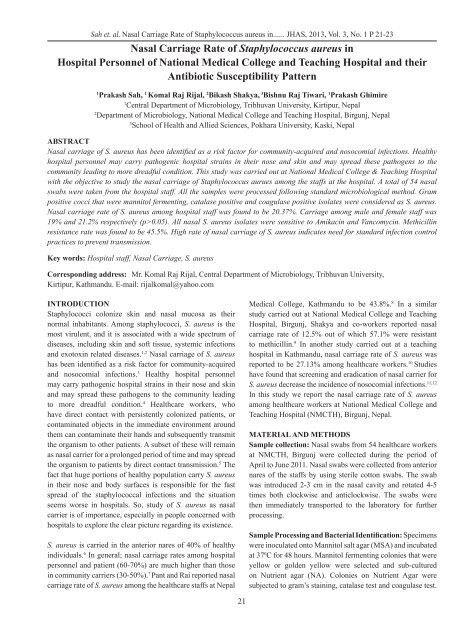
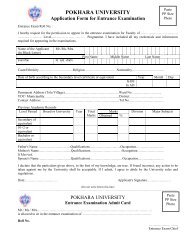
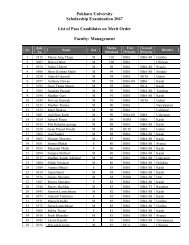
![kl/R5]b - Pokhara University](https://img.yumpu.com/47165105/1/184x260/kl-r5b-pokhara-university.jpg?quality=85)
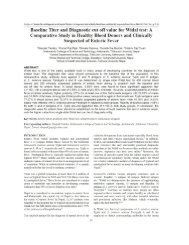

![kf]v/ f ljZjljBfno a'n ]l6g - Pokhara University](https://img.yumpu.com/41745825/1/190x245/kfv-f-ljzjljbfno-an-l6g-pokhara-university.jpg?quality=85)
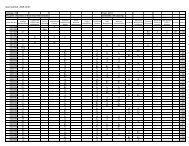
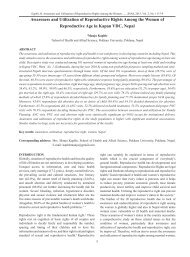

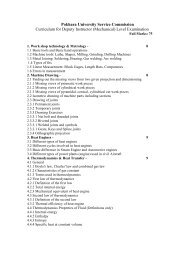
![kf]v/f ljZjljBfno ;efsf] a}7s ;~rfng - Pokhara University](https://img.yumpu.com/30513181/1/184x260/kfv-f-ljzjljbfno-efsf-a7s-rfng-pokhara-university.jpg?quality=85)
